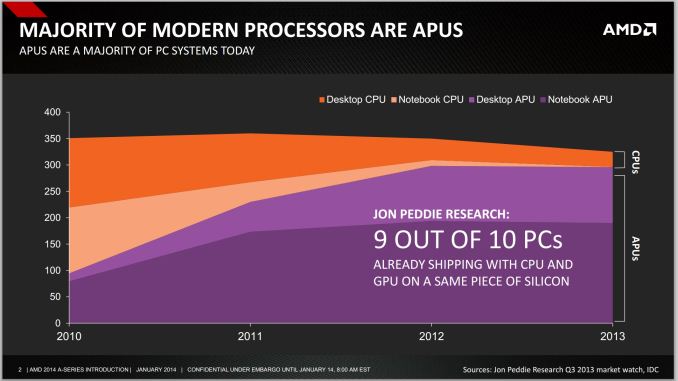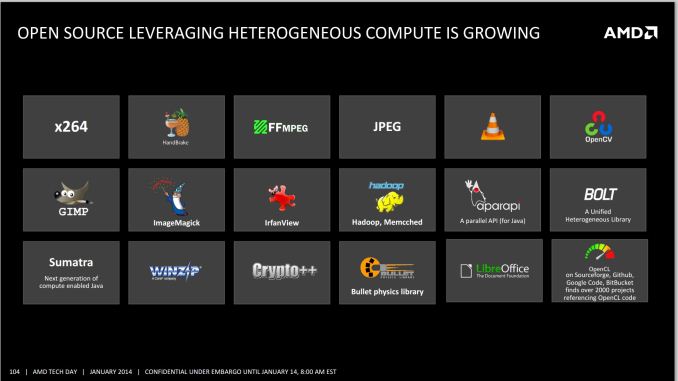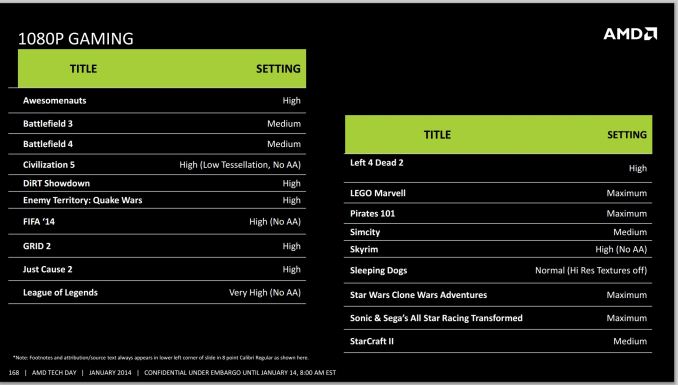AMD Kaveri Review: A8-7600 and A10-7850K Tested
by Ian Cutress & Rahul Garg on January 14, 2014 8:00 AM ESTKaveri: Aiming for 1080p30 and Compute
The numerical differences between Kaveri and Richland are easy enough to rattle off – later in the review we will be discussing these in depth – but at a high level AMD is aiming for a middle ground between the desktop model (CPU + discrete graphics) and Apple’s Mac Pro dream (offloading compute onto different discrete graphics cards) by doing the dream on a single processor. At AMD’s Kaveri tech day the following graph was thrown in front of journalists worldwide:
With Intel now on board, processor graphics is a big deal. You can argue whether or not AMD should continue to use the acronym APU instead of SoC, but the fact remains that it's tough to buy a CPU without an integrated GPU.
In the absence of vertical integration, software optimization always trails hardware availability. If you look at 2011 as the crossover year when APUs/SoCs took over the market, it's not much of a surprise that we haven't seen aggressive moves by software developers to truly leverage GPU compute. Part of the problem has been programming model, which AMD hopes to address with Kaveri and HSA. Kaveri enables a full heterogeneous unified memory architecture (hUMA), such that the integrated graphics topology can access the full breadth of memory that the CPU can, putting a 32GB enabled compute device into the hands of developers.
One of the complexities of compute is also time: getting the CPU and GPU to communicate to each other without HSA and hUMA requires an amount of overhead that is not trivial. For compute, this comes in the form of allowing the CPU and GPU to work on the same data set at the same time, effectively opening up all the compute to the same task without asynchronous calls to memory copies and expensive memory checks for coherency.
The issue AMD has with their HSA ecosystem is the need for developers to jump on board. The analogy oft cited is that on Day 1, iOS had very few apps, yet today has millions. Perhaps a small equivocation fallacy comes in here – Apple is able to manage their OS and system in its entirety, whereas AMD has to compete in the same space as non-HSA enabled products and lacks the control. Nevertheless, AMD is attempting to integrate programming tools for HSA (and OpenCL 2.0) as seamlessly as possible to all modern platforms via a HSA Instruction Layer (HSAIL). The goal is for programming languages like Java, C++ and C++ AMP, as well as common acceleration API libraries and toolkits to provide these features at little or no coding cost. This is something our resident compute guru Rahul will be looking at in further detail later on in the review.
On the gaming side, 30 FPS has been a goal for AMD’s integrated graphics solutions for a couple of generations now.
Arguably we could say that any game should be able to do 30 FPS if we turn down the settings far enough, but AMD has put at least one restriction on that: resolution. 1080p is a lofty goal to hold at 30 FPS with some of the more challenging titles of today. In our testing in this review, it was clear that users had a choice – start with a high resolution and turn the settings down, or keep the settings on medium-high and adjust the resolution. Games like BF4 and Crysis 3 are going to tax any graphics card, especially when additional DirectX 11 features come in to play (ambient occlusion, depth of field, global illumination, and bilateral filtering are some that AMD mention).













380 Comments
View All Comments
thomascheng - Wednesday, January 15, 2014 - link
I think when the updated drivers (end of this month?) are release that might be different. Another thing about the APU, is that it is a bit more future proof with OpenCL becoming more popular. I personally won't get one now, but I might bite once there is a price drop to $160.YuLeven - Wednesday, January 15, 2014 - link
I don't put any faith on drivers. If a driver improves Kaveri's GCN 1.1 GPU, it will likely do the same for a GCN 1.0 dGPU. The cheap Pentium + dGPU is still a Kaveri killer.What I wanted to see is dual graphics working to the point where Kaveri + very cheap dGPU would beat a Pentium + cheap dGPU. Perhaps in some of this scenarios Kaveri would make a great choice.
However dual graphics are so broken that for now I can only but hope. In some cases I personally saw a dual graphics solution show higher FPS, but look actually choppier due bad cases of micro stuttering.
mr_tawan - Wednesday, January 15, 2014 - link
AFAIK in my country (Thailand), APUs are quite popular in internet cafe's gaming machines. They are cheap, yet powerful enough driving online games. This might also be the case for countries like China or Korea where internet cafe also provide gaming services, I guess.And that might be how 1/3 machine figure come. I guess.
silverblue - Tuesday, January 14, 2014 - link
You're talking a GDDR5-based PC - as nice as that sounds, it's totally at odds with current system setups. In addition, would you really want eight Jaguar cores? Kaveri would outperform them in its slowest 2M/4C configuration, and single threaded speed would be significantly slower with a 1.6GHz Cat core.Or you could just buy a PS4... helps AMD either way, and you get what you want.
Until we see Mantle, TrueAudio and HSA in action, Kaveri will remain underwhelming to most. It's kind of strange to bring out the hardware without the software.
rauelius - Tuesday, January 14, 2014 - link
This would help make an AMAZINGLY tiny Steam Machine....I just hope the drivers are therenathanddrews - Tuesday, January 14, 2014 - link
Would it? That probably depends on what kind of Steam machine you mean. It can't play games very well on its own and would be more power than you need to stream from a more powerful machine. Seems like at best it would be an entry-level Steam machine for 720p gaming... and even then it would cost about the same as a cheap Intel CPU + low-profile 7750, which would provide better gaming performance.If you were only going to stream games from another machine, the NVIDIA Shield would be a smaller and cheaper alternative that you can take anywhere in the house.
veri745 - Tuesday, January 14, 2014 - link
FYI, the "Average" framerate button for the Bioshock Infinite "Xtreme" settings benchmark actually brings up the chart for the "Performace" settings.UtilityMax - Tuesday, January 14, 2014 - link
Outside of the "grandpa gamer" market, which is tiny, the APU so far seems to induce a big yawn. The HSA and Mattle benefits won't be mainstream for quite some time, so they're not a consideration for someone buying an APU this year. AMD promised originally 20-30% improvement in both CPU performance and GPU performance over Richland A10. In this sense, the new Kaveri A10 APU is a disappointment, in many tests struggling to beat Richland parts by any meaningful margin (or the Haswell i3 in tests now using graphics).I do like how much the A8 has improved. It has a lowish TDP, and yet not significantly slower than the A10. Considering the "product positioning" price of $112 from the graph above, the A8 makes sense as APU for a cheap "grandpa"/"kid" gaming rig or a general purpose computer. It's only slightly slower for CPU compute than the i3 costing $20, but much faster in games.
UtilityMax - Tuesday, January 14, 2014 - link
Sorry, meant to say "not using any graphics" in my reference to i3.dgingeri - Tuesday, January 14, 2014 - link
Seriously, I wonder why they bothered with covering this. The desktop is definitely not the place for this chip. It could potentially be competitive in laptops, but only if they cut the price. If Intel didn't exist, this would be a decent chip, but as it is, Intel beats down AMD in every market except low end SMB servers.